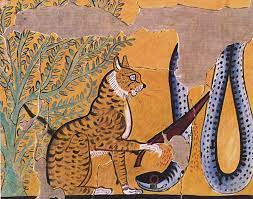When you visit art galleries, you will probably see artworks with cats depicted in them. Over centuries cats have been included in many paintings. There are famous cat paintings where cats are the main subjects, but in many other paintings, it seems like a cat is depicted as “an extra” with no logical reason to be there.
This is because cats in artworks might have symbolic value and are often included in a painting to convey a specific message. The symbolic value is not always the same – it varies from art period to art period, and sometimes even from painter to painter in the same period.
For some artists, for instance, cats symbolize feral femininity, and others use cats as expressions of innocence in children’s portraits. And while some Renaissance paintings of cats convey evil messages, other artists see cats as symbolic of rebirth. In this article, we’ll look at this apparent diversity of roles.
Famous Cat Art
Let’s start with the “easy” part, where cats were depicted as the subject or part of the subject without any specific symbolic value. One such painting is “The Bachelor Party” by Louis Wain. It was painted in1896 and is considered by most art lovers and historians as one of the most famous cat paintings.
It features a comical scene of a group of cats gathered around a table, enjoying a few drinks and smoking cigars. But, it is just a painting to be enjoyed! There is no hidden message incorporated into the artwork.
Another favorite famous cat painting is “Julie Manet(Child with Cat)” by Pierre-Auguste Renoir. It was painted in 1887 and is simply a portrait of a little girl holding her cat.
Franz Marc’s “The White Cat” is one of the most famous paintings of cats done in modern art history. The artwork was completed in 1912 and only depicted a sleeping white cat. Unfortunately, no symbols or messages are included to be solved!
The Role of Cats in Ancient Egyptian Religious Art
The domestic cat has been with us for thousands of years and has appeared in the art for just as long. The Egyptians, for instance, worshiped Bastet, the cat goddess.
They erected a temple for her and filled it with artworks – more than 600 cat statues. The Egyptians created those art objects to worship the cat goddess and to honor her domesticity, fertility, and women’s intuition.
Although cats were family pets in ancient Egypt and represented the cat-goddess Bastet, cats were also associated with other gods. For example, cats also represented the Sun-god Ra, and many depictions of cats in this capacity were created.
Renaissance Paintings of Cats
During the Renaissance art period, it was the custom to use cats in paintings to convey specific messages to the viewer. The symbolic value of a cat in a painting was a given. Art historians believe that although cats have been, to a certain extent, carrying symbolic value and messages in all art periods, the Renaissance period was the period where artists used cat-related symbolism the most.
“Adam and Eve” by Albrecht Dürer (1471-1528) is a good example. The cat in the engraving represents the trait of being easily angered or irritated. The cat and the mouse in the picture symbolize men and women’s sexual lust.
Another artwork using a cat to convey a “secret message” to the viewer is Domenico Ghirlandaio’s “Last Supper” (1480). It depicts a cat at the feet of the apostle Judas. The cat symbolizes Judas’ treason and evil.
But not all cat depictions were meant for symbolic messages. Leonardo da Vinci, for instance, made many sketches and paintings of cats only because he was fond of cats.
The Role of Cats in other Art Periods
The different symbolic value of cats in an artwork is diverse. For Picasso, cats symbolized feral femininity. He usually painted them where they are slashing into birds and lobsters. Some Victorian painters used cats to “soften” their portraits of children. To them, cats were the expression of innocence.
The viewer is often “invited” to give their meaning of why a cat has been included in the painting. For example, in 1853, Holman Hunt depicted a cat in “The Awakening Conscience,” where a woman sits on a man’s lap at a piano. There is endless speculation amongst art historians and scholars what the meaning and symbolic value of the cat in the corner are. The cat is depicted with a bird caught, but the viewer doesn’t know whether the bird is about to fly away or be eaten. This might symbolize that you also don’t know whether the woman has been caught or is escaping.
In Manet’s “Olympia,” a nude courtesan reclines in bed with a black cat at her feet. The woman’s black servant stands with a large bouquet of flowers behind the black cat. Some art critics see the cat as a symbol of the racism of the era.
Sometimes the cat in a painting symbolizes what the viewer is most probably experiencing when looking at the artwork. John Everett Millais’ 1870 artwork “The Flood” is a perfect example of this. He painted a black cat in a cradle with a baby who had been swept away during the Great Sheffield flood that had killed 250 people. This famous cat painting shows the baby lying placidly in a cradle as it’s swept away. At the infant’s foot, the cat yowls in terror, and these yowls symbolize the viewer’s fear at the fate awaiting the baby.
Conclusion
Apart from artworks where cats are depicted just as a pet, there are cats in some paintings for specific symbolic values. Unfortunately, in many instances, we, as the viewers, miss the symbolic meaning of the cat in the painting because we are not always aware of the meanings contributed to cats during the time of the creation of the artwork. Fortunately, most galleries’ guide books explain the symbolic value of each painting.
